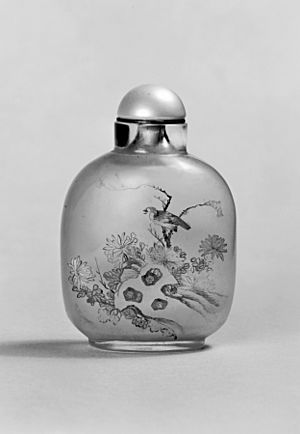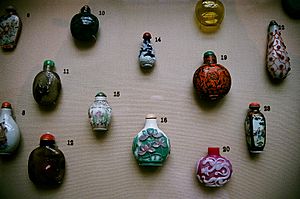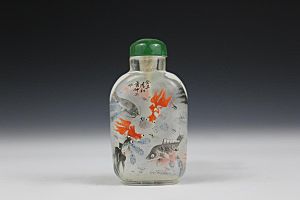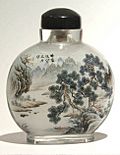Snuff bottle facts for kids
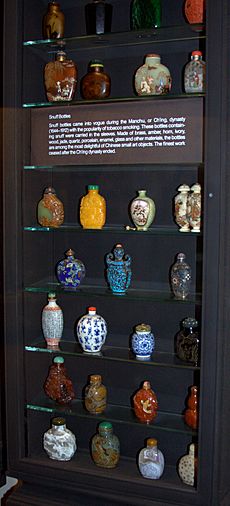
Snuff bottles are small containers that were used in China during the Qing Dynasty. People used them to carry powdered tobacco, called snuff. Even though smoking tobacco was not allowed during the Qing Dynasty, using snuff was permitted. This was because people in China believed snuff could help with common sicknesses. They thought it could treat colds, headaches, and stomach problems. So, snuff was carried in these tiny bottles, just like other medicines. These special bottles took the place of the larger snuff boxes that were popular in Europe.
Contents
The Story of Snuff Bottles
Tobacco first arrived in China, specifically at the court in Beijing, around the mid-to-late 1500s. At first, people smoked tobacco using pipes. But before the Qing Dynasty began, snuff and its small bottles started to become popular.
How Snuff Bottles Became Popular
By the late 1600s, using snuff and carrying these bottles became a common social practice among the upper class. This trend continued for most of the 1700s. Eventually, it spread across the whole country and to people from all walks of life. It became a polite way to greet friends and family by offering them a small pinch of snuff. Soon, snuff bottles were not just useful; they were also seen as beautiful art. They became a way for people to show off their wealth and importance.
Snuff Bottles Today
The popularity of snuff bottles went up and down with the Qing Dynasty. After the Republic of China was formed, their use faded away. However, new snuff bottles are still made today. You can find them in souvenir shops, flea markets, and museum stores.
Old snuff bottles from the Qing period are very sought after by serious collectors and museums. A truly good bottle has more than just beauty and value. It also has a special feel. These bottles were made to be held, so they usually feel very nice to touch.
Later, a new type of snuff bottle appeared. These were called "inside painted" bottles. This art combined traditional Chinese painting with the skill of making snuff bottles. Many traders from Western countries loved this beautiful craft. They collected many high-quality old inside-painted bottles. Works by famous inside painters, like Ma Shaoxuan and Ye Zhongsan, are often sold at important auctions. Today, inside-painted snuff bottles are still created and are seen as true works of art. Some master artists, like Wang Xisan, create pieces that are considered precious artworks, not just souvenirs.
Materials and Sizes of Snuff Bottles
Snuff bottles are small enough to fit comfortably in the palm of your hand. They were made from many different materials. Some common materials included porcelain, jade, ivory, and wood. Other materials used were rhinoceros horn, coconut shells, lapis lazuli, gneiss, cork, chalcedony, jasper, carnelian, malachite, quartz, tortoiseshell, metal, turquoise, agate, mother-of-pearl, and ceramic. However, glass was probably the most common material.
The top of the bottle, called the stopper, usually had a tiny spoon attached to it. This spoon was used to take out the snuff. While rare, women in Europe also used similar small bottles during Victorian times. These European bottles were typically made of cut glass.
Chinese snuff bottles were often decorated with paintings or carvings. These decorations showed how good the bottle was and how much it was worth. Making these fancy bottles took a lot of time and effort. Because of this, they are still highly valued by collectors today.
"Inside Painted" Bottles
Inside painted snuff bottles are made of glass. They have detailed pictures and often calligraphy painted on the inside surface of the bottle.
The Amazing Art of Inside Painting
The scenes painted inside these bottles are only about one or two inches tall. Artists paint them by putting a tiny brush through the bottle's narrow neck, which might be only a quarter-inch wide. They have to paint everything in reverse! Ursula Bourne, who studied snuff, suggested that artists might have painted while lying on their backs. This would make it easier to work through the small opening.
A skilled artist can finish a simple bottle in about a week. But a very special bottle might take a month or even half a year to complete. The best artists might only create a few bottles in an entire year.
History of Inside Painting
Gan Xuanwen, also known as Gan Xuan, is known as an important early artist of inside-painted snuff bottles in China. Many of his bottles have dates on them. This helps us know that his works were made around the early 1800s, during the late Jiaqing (1796-1820) and early Daoguang (1821-1850) periods of the Qing Dynasty.
Inside-painted snuff bottles became very popular in the early 1800s. Even though they might have started at the royal court, the imperial workshops did not support them. Still, these bottles quickly became popular with a new group of buyers. This group included officials, nobles, scholars, and business people. This art form became very strong in the late Qing Dynasty and early Republic periods, from the late 1800s to the early 1900s. In Beijing, there were three very famous and important masters: Zhou Leyuan, Ma Shaoxuan, Ding Erzhong, and Ye Zhongsan. Today, inside-painted bottles are still made for collectors. They are becoming even more valuable as works of art in modern times.
The themes for inside-painted bottles include beautiful landscapes, birds and flowers, people, and lucky symbols. These bottles are like tiny paintings captured inside glass.


